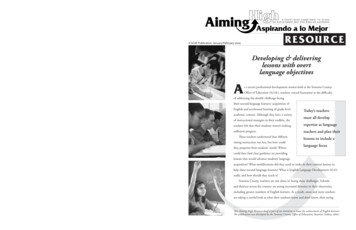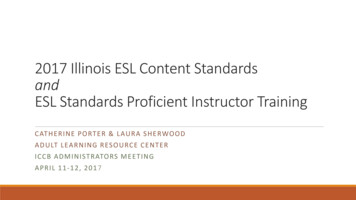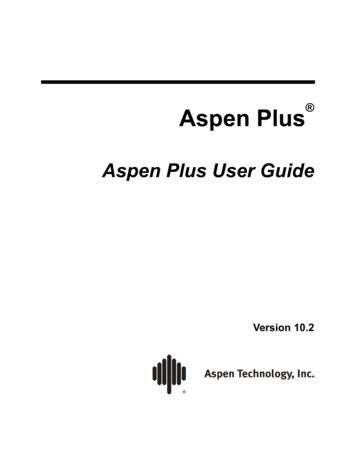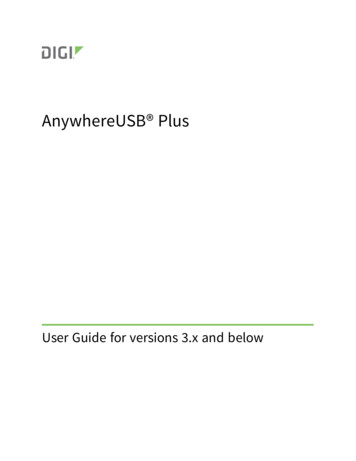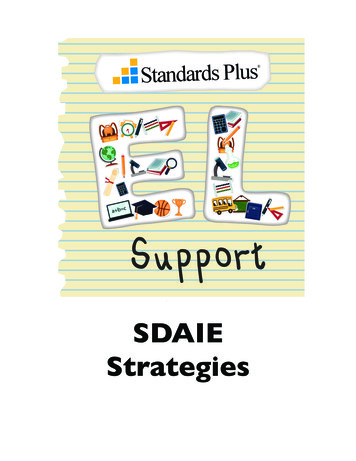
Transcription
Standards Plus Su pp or tSDAIEStrategies
ELD/SDAIE StrategiesTotal Physical Response – acting out the directions that are given in English. Twoexamples of this are Simon Says or Mother, May I?Asking Questions for Appropriate Responses – initially, students must begiven the opportunity to answer using gestures and one or two words to show whatthey know. Receptive language develops before expressive language, so students maybe able to get the gist of what is being asked of them even if they cannot yet respondorally in English. WARNING: If you ask a question that can only be answered in a sentence or with a long explanation, the English Learner will not be able to respond. (Youdefinitely get what you ask for in this scenario.) Think about embedding the answer inthe question for students who are very new to the English language.Oral Interaction – students should be interacting with each other in addition tointeracting with the teacher. Time to talk in pairs, at table groups, etc. allow studentsto “rehearse” their responses before saying them aloud.Prior Knowledge and Cultural Perspectives – as you plan a new lesson, beaware of the prior knowledge and cultural perspectives of the students in your classroom. Think about how the new information will integrate with what they alreadyknow. Think about how the new information will fit with their life experiences.Use Standard English – avoid using idioms, figurative language, acronyms, andslang whenever possible. While these language forms permeate the English language,they get in the way of the meaning of the content. Use precise language that is ageand content appropriate. Use relevant synonyms or cognates of the students’ nativelanguages when possible.2www.standardsplus.org 2011 Learning Plus Associates
ELD/SDAIE StrategiesMovement – when you add a movement, you allow students to use additional modalities for learning, and you give students additional methods for comprehending theconcepts you are presenting.MONITOR, MONITOR, MONITOR – there is a delicate balance in languagedevelopment. The goal is to build the layers of language as students are ready to access them. This means that you must know when students are ready for more. Beaware of when students move from gestures to single word answers. Then, again,when students begin to use multiple words, phrases, and simple sentences. They willuse and confuse rules as they make generalizations about how English works.Make Corrections Implicit (Not EXPLICIT!) – students must feel that theyare building language and that it is expected and normal to make errors along the way.They need to know that it is wrote not writed, but hearing the sentence spoken correctly is sufficient for them to begin to know this distinction. All language expressionneeds to be low risk for the student. Fear of making a mistake will stunt development.Games, Songs, Activities – engage students in language in a way that is fun orentertaining. This is a low risk way of exploring language. Be careful of the competitive nature of the students, though. Competition can make low risk activities into highrisk experiences for some students.Graphic Organizers – these are helpful in making new concepts clear and showinghow new concepts relate to prior knowledge.www.standardsplus.org 2011 Learning Plus Associates3
ELD/SDAIE StrategiesDon’t Over-Emphasize Pronunciation or Grammar – pronunciation andgrammar will develop over time, and the teacher should enunciate and pronouncewords clearly and use correct grammar as an example for the students. Trying to betoo correct, however, can get in the way of learning to use English.Know the Goals – perhaps the most important thing the teacher of the EnglishLearner can do is to be clear about the objective of the lesson. This provides thebackbone of any instruction and interaction that follows.Repetition – students need to hear language over and over and over again in orderfor it to become a permanent part of their personal vocabulary. When working withcontent, students need to hear the same information several times. This will helpthem to gain familiarity with the concepts and the language associated with them.Visuals / Manipultatives / Realia – whenever a visual, manipulatives, or realiacan be used in a lesson, it should be used. These help students to comprehend theconcept even if they do not yet have adequate language to understand informationthat is presented orally or in writing. They help students to attach new learning toprior knowledge and to remember better the content that has been presented.Recording & Posting Academic Vocabulary – students need to have resources at their disposal if the expectation is that they will use them. Students shouldbe actively involved with the recording of the vocabulary, and it should be posted withthe students present. This will help the student to have ownership of the vocabulary.4www.standardsplus.org 2011 Learning Plus Associates
ELD/SDAIE StrategiesModel, Model, Model – this is essential for all learners but especially the EnglishLearner. Telling a student what to do or how to do something is not nearly as effectiveas showing a student what to do or how to do something.Drawing – students may be able to draw a picture or diagram to show what theyknow while they are still developing written language competency. As students develop, they may add labels or captions to their drawings. Later, drawings can be the firstpart of drafting their response to a question or an assignment.Art, Media, Drama – offer opportunities for students to express themselvesthrough art, media, or dramatic means. Also, these are strong instructional components that can help students to make meaning about the content.Preview / Review – use this strategy when presenting a piece of text. Begin bypreviewing the text. Read the title and any headings or subheadings. Notice any boldor italicized words or phrases. If there are pictures, captions, or other graphics, lookat them. In pairs, small groups, or as a whole class, talk about the information that youhave discovered in the preview. The idea is that the students should have a good ideaof what to expect when they actually read the text. If there are vocabulary terms thatneed to be taught or reinforced, this is the time to do it. Then, read the text. Studentscan read silently, pair read, chorally read, or listen to the teacher read the text. Repeated readings can be achieved through using a combination of silent and oral readings. When the students have read the text, go back and review the predictions andvocabulary from the preview. If there is a response activity (e.g., comprehension questions, summary, etc.), explain what is required and discuss how to answer, where theinformation can be found in the text, and any other expectations that you may have.www.standardsplus.org 2011 Learning Plus Associates5
Providing Think Time &Keeping All Students EngagedProviding Think Time – students may be attempting to translatewhat you have said to their native language, considering an answer,translating the answer to English, and mentally rehearsing the answer,before being able to respond to the question aloud. This requires thinktime. In a classroom with native English speakers and English Learners,it takes work to make sure the English Learners have adequate thinktime when the native English speakers are ready to respond almost immediately. There are strategies that are helpful in keeping the balancewith the native English speakers and English Learners in a single classroom that follow this document.It can be very difficult to keep all students engaged in the instruction if thereis a lot of wait time. Try these strategies to engage the quick thinkers and language proficient students in your classroom. This will help to keep the pressure on the English Learner at a low degree while they work out responses.1.Prompt students for more information while English Learners are thinking:Question: Who were the three main characters in the story?Sub-question: For those of you who already know the answer, write thethree characters’ names in order of most important to least important.6www.standardsplus.org 2011 Learning Plus Associates
Providing Think Time &Keeping All Students Engaged2.Have students with well-developed language record their group’s thoughts.Pose the question or activity to the whole class. Then, tell the studentsthey have 1-3 minutes to think about their response. While the group isthinking, the recorder prepares to take notes. The group discusses thequestion or activity, and the recorder takes notes on what is said. Then,the group determines the correct response, and the recorder writes theresponse. This slows down that student who is ready to answer right now,and it gives everyone an opportunity to actively engage in the discussion.3.4.Tell students that any time they know an answer right away, it is their jobto write what they think should be a question you will ask. They must usethe academic language that you would use in their question. Call on students with follow-up questions or have them post their questions on an “Iwonder” bulletin board for future discussion.Have students write a sentence or phrase telling how they know the answer to the question that has been posed. Proper sentence structure,spelling, and academic vocabulary is required.www.standardsplus.org 2011 Learning Plus Associates7
Prior Knowledge and Cultural Perspectives – as you plan a new lesson, be aware of the prior knowledge and cultural perspectives of the students in your class-room. Think about how the new information will integrate with what they already know. Think about how the new information will fit with their life experiences. Use Standard English – avoid using idioms, figurative language, acronyms .
